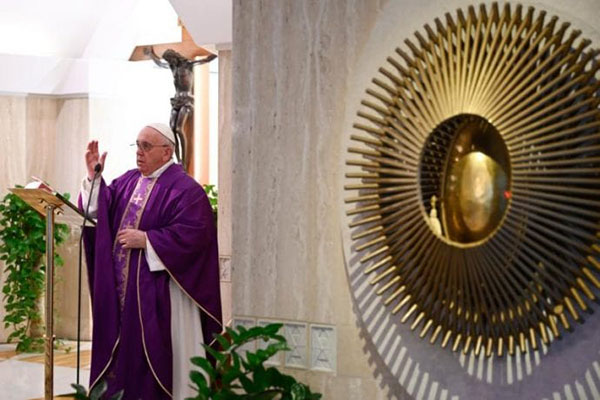
By Elise Anne Allen
ROME (Crux) — As many of the restrictions imposed early on by Italy to fight the COVID-19 coronavirus begin to be adopted elsewhere, the number of Catholics unable to get to Mass, or at least strongly discouraged from leaving the house to do so, is growing.
One novel attempt to fill that void is what might be called Pope Francis’s impromptu “virtual parish.”
Since March 9, after the Italy’s national lockdown was imposed, the Holy Father has been livestreaming his daily Mass at the Santa Marta residence in the Vatican, which previously had always been celebrated in private, with a synopsis published by the Vatican media services. In addition, the pontiff’s weekend Masses are also being livestreamed; previously, his weekend liturgies were only publicized if they were open to the general public.
As of March 16, the papal Mass was attracting a live audience of about 6,000 people, the size of a large parish. Most were watching on Facebook and mostly in the Italian original, which is unsurprising given the 7:00 a.m. start time in Rome, which right now works out to 2:00 a.m. on the East Coast of the U.S.
There were, however, a hearty band of more than 900 English-speakers following the live translation provided by the Vatican on Facebook and Youtube.
Joining Pope Francis each morning is a small cast of regulars, made up of members of his own household. In effect, the pontiff is trapped at home with his own family just like everyone else in Italy, where the total number of infections as of Monday evening was 24,747. The total number of deaths due to the virus was 1,809, and the number of people cured was 2,335.
The Holy Father’s household includes three priests, two layman and a small cluster of nuns from the Vincentian Daughters of Charity, who have run the Santa Marta guesthouse since the late 1800s, when it was still operating as a hospice in the original building which used to exist on the site.
Each morning during Mass one of the nuns does the first reading.
When he celebrates Mass, Pope Francis is also flanked by two laymen: Sandro Mariotti and Peirgiorgio Zanetti, two “papal butlers.”
Mariotti was hired after the exit of Paolo Gabriele, who worked under Pope Emeritus Benedict XVI and was convicted for leaking confidential letters to the press, causing 2012’s “Vatileaks” scandal.
Zanetti has known Pope Francis since he was known as Cardinal Jorge Mario Bergoglio, often assisting him when he visited Rome while Archbishop of Buenos Aires. He was a member of the Vatican’s police force before stepping into his current role.
Marotti and Zanetti are often seen collecting letters and gifts during the pontiff’s private and public audiences, and distributing rosaries and medals to his guests. The two men also take care of the pontiff’s clothing and prepare his bags when he travels abroad.
Sitting in the chairs lined up inside the chapel alongside the sisters are Pope Francis’s secretaries, Uruguayan Father Gonzalo Aemilius and Egyptian Monsignor Yoannis Lahzi Gaid.
Before Pope Francis’s election, Fr. Aemilius had caught Bergoglio’s attention for his work with youth living on the streets in Montevideo. He took over for the pontiff’s former secretary, Monsignor Fabián Pedacchio Leaniz, who in 2019 returned to his full-time job at the Congregation for Bishops.
Msgr. Gaid is a Coptic Catholic priest who was named second secretary to Pope Francis in 2014, making him the first Eastern rite priest to hold the position.
Both Msgr. Gaid and Fr. Aemilius concelebrate the Mass with Pope Francis, however, instead of standing with him at the altar, they recite their portions of the Eucharistic Prayer from their seats, keeping the appropriate distance required under the coronavirus restrictions.
Also at Pope Francis’s side during his daily Mass is Monsignor Assuntino Scotti, an Italian priest who also belongs to the Vincentian spiritual family. He is the person who oversees requests to participate in the pontiff’s daily Mass and is the priest reads the Gospel during Pope Francis’s livestreamed Masses.
Normally the chapel on a given day would be filled with additional priests and around 25 guests who got the green light from Msgr. Scotti, however, it is now notably empty.
As the coronavirus increasingly prevents swaths of Catholics around the world from attending Mass, parishes throughout Rome and Italy generally have also launched their own virtual liturgies, with many opting to livestream Masses at the usual times for parishioners who want to tune in via Youtube or Facebook.
In one Roman neighborhood a priest celebrated Mass on top of a roof, so Catholics in the area would be able to follow from their buildings and make an act of spiritual communion – a prayer recited in the event that a person is unable to physically receive the Eucharist, for whatever reason.
And as similar restrictions are increasing throughout the United States and other parts of the world, the congregation of the pontiff’s “virtual parish” will continue to grow, and other local one’s will also rise up to feed the spiritual hunger during the ongoing crisis.

“Virtual Parish” – is effective in these challenging times.